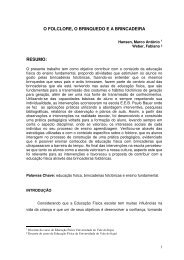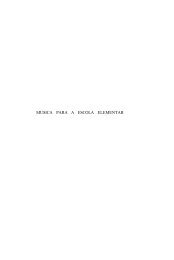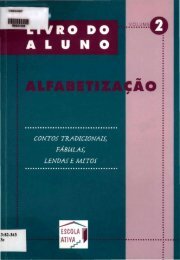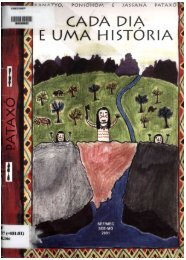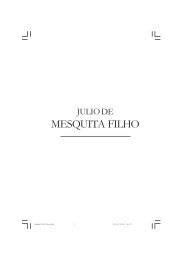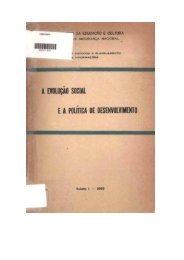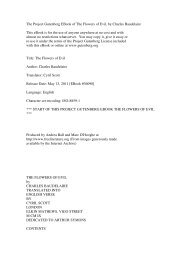A History of English Literature
A History of English Literature
A History of English Literature
Create successful ePaper yourself
Turn your PDF publications into a flip-book with our unique Google optimized e-Paper software.
triumph <strong>of</strong> Pseudo-classicism, as a reassertion <strong>of</strong> those instincts in human<br />
nature which Pseudo-classicism disregarded, took the form <strong>of</strong> a distinct<br />
Romantic Revival. Beginning just about as Pope's reputation was reaching<br />
its climax, and gathering momentum throughout the greater part <strong>of</strong> the<br />
eighteenth century, this movement eventually gained a predominance as<br />
complete as that which Pseudo-classicism had enjoyed, and became the chief<br />
force, not only in England but in all Western Europe, in the literature <strong>of</strong><br />
the whole nineteenth century. The impulse was not confined to literature,<br />
but permeated all the life <strong>of</strong> the time. In the sphere <strong>of</strong> religion,<br />
especially, the second decade <strong>of</strong> the eighteenth century saw the awakening<br />
<strong>of</strong> the <strong>English</strong> church from lethargy by the great revival <strong>of</strong> John and<br />
Charles Wesley, whence, quite contrary to their original intention, sprang<br />
the Methodist denomination. In political life the French Revolution was a<br />
result <strong>of</strong> the same set <strong>of</strong> influences. Romanticism showed itself partly in<br />
the supremacy <strong>of</strong> the Sentimental Comedy and in the great share taken by<br />
Sentimentalism in the development <strong>of</strong> the novel, <strong>of</strong> both <strong>of</strong> which we shall<br />
speak hereafter; but its fullest and most steadily progressive<br />
manifestation was in non-dramatic poetry. Its main traits as they appear in<br />
the eighteenth century are as clearly marked as the contrasting ones <strong>of</strong><br />
Pseudo-classicism, and we can enumerate them distinctly, though it must <strong>of</strong><br />
course be understood that they appear in different authors in very<br />
different degrees and combinations.<br />
1. There is, among the Romanticists, a general breaking away not only from<br />
the definite pseudo-classical principles, but from the whole idea <strong>of</strong><br />
submission to fixed authority. Instead there is a spirit <strong>of</strong> independence<br />
and revolt, an insistence on the value <strong>of</strong> originality and the right <strong>of</strong> the<br />
individual to express himself in his own fashion. 2. There is a strong<br />
reassertion <strong>of</strong> the value <strong>of</strong> emotion, imagination, and enthusiasm. This<br />
naturally involves some reaction against the pseudo-classic, and also the<br />
true classic, regard for finished form. 3. There is a renewal <strong>of</strong> genuine<br />
appreciation and love for external Nature, not least for her large and<br />
great aspects, such as mountains and the sea. The contrast between the<br />
pseudo-classical and the romantic attitude in this respect is clearly<br />
illustrated, as has <strong>of</strong>ten been pointed out, by the difference between the<br />
impressions recorded by Addison and by the poet Gray in the presence <strong>of</strong> the<br />
Alps. Addison, discussing what he saw in Switzerland, gives most <strong>of</strong> his<br />
attention to the people and politics. One journey he describes as 'very<br />
troublesome,' adding: 'You can't imagine how I am pleased with the sight <strong>of</strong><br />
a plain.' In the mountains he is conscious chiefly <strong>of</strong> difficulty and<br />
danger, and the nearest approach to admiration which he indicates is 'an<br />
agreeable kind <strong>of</strong> horror.' Gray, on the other hand, speaks <strong>of</strong> the Grande<br />
Chartreuse as 'one <strong>of</strong> the most solemn, the most romantic, and the most<br />
astonishing scenes.... I do not remember to have gone ten paces without an<br />
exclamation that there was no restraining. Not a precipice, not a torrent,<br />
nor a cliff, but is pregnant with religion and poetry.' 4. The same<br />
passionate appreciation extends with the Romanticists to all full and rich<br />
beauty and everything grand and heroic. 5. This is naturally connected also<br />
with a love for the remote, the strange, and the unusual, for mystery, the<br />
supernatural, and everything that creates wonder. Especially, there is a<br />
great revival <strong>of</strong> interest in the Middle Ages, whose life seemed to the men<br />
<strong>of</strong> the eighteenth century, and indeed to a large extent really was,<br />
picturesque and by comparison varied and adventurous. In the eighteenth<br />
century this particular revival was called 'Gothic,' a name which the<br />
Pseudo-classicists, using it as a synonym for 'barbarous,' had applied to<br />
the Middle Ages and all their works, on the mistaken supposition that all<br />
the barbarians who overthrew the Roman Empire and founded the medieval<br />
states were Goths. 6. In contrast to the pseudo-classical preference for<br />
abstractions, there is, among the Romanticists, a devotion to concrete





